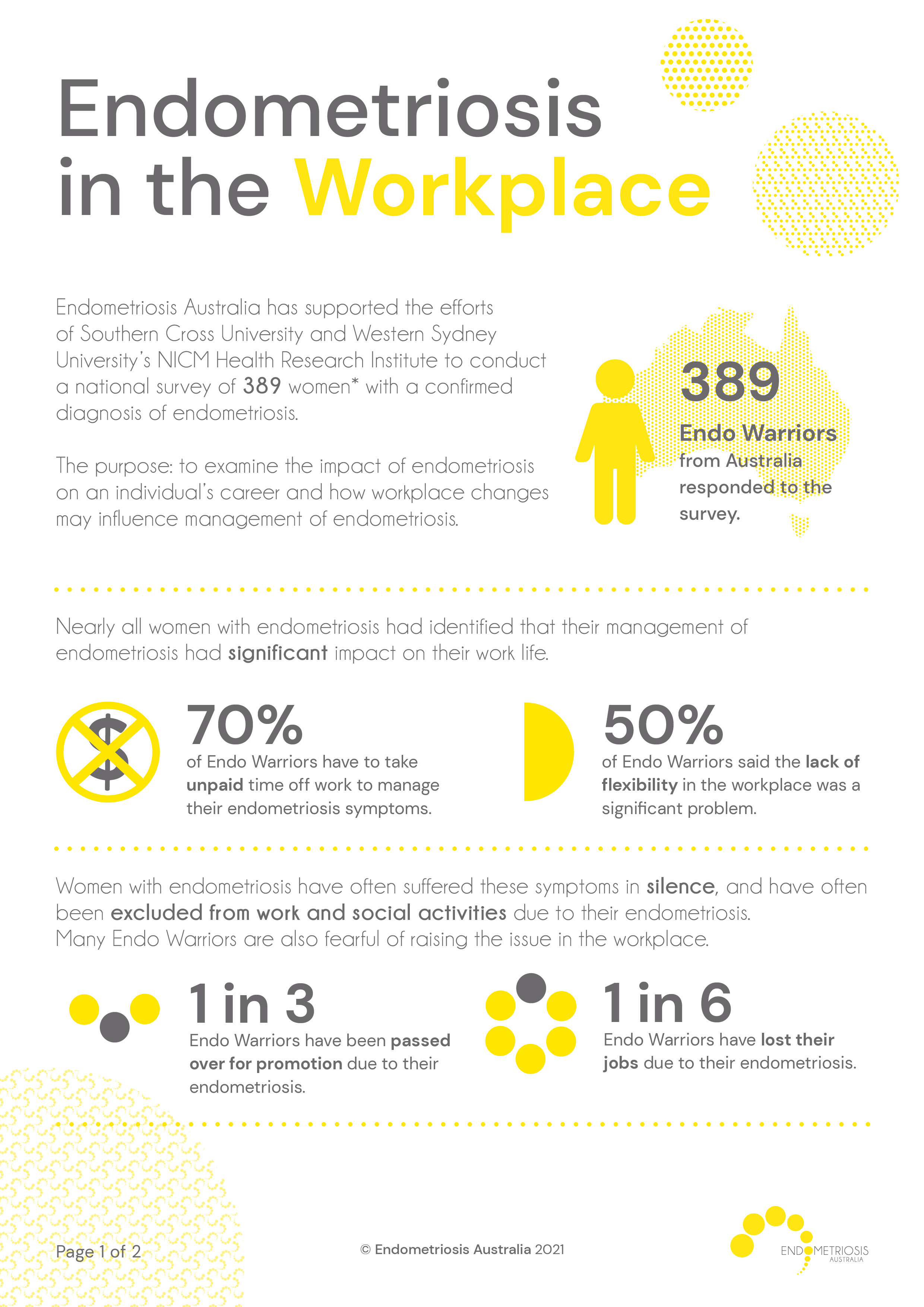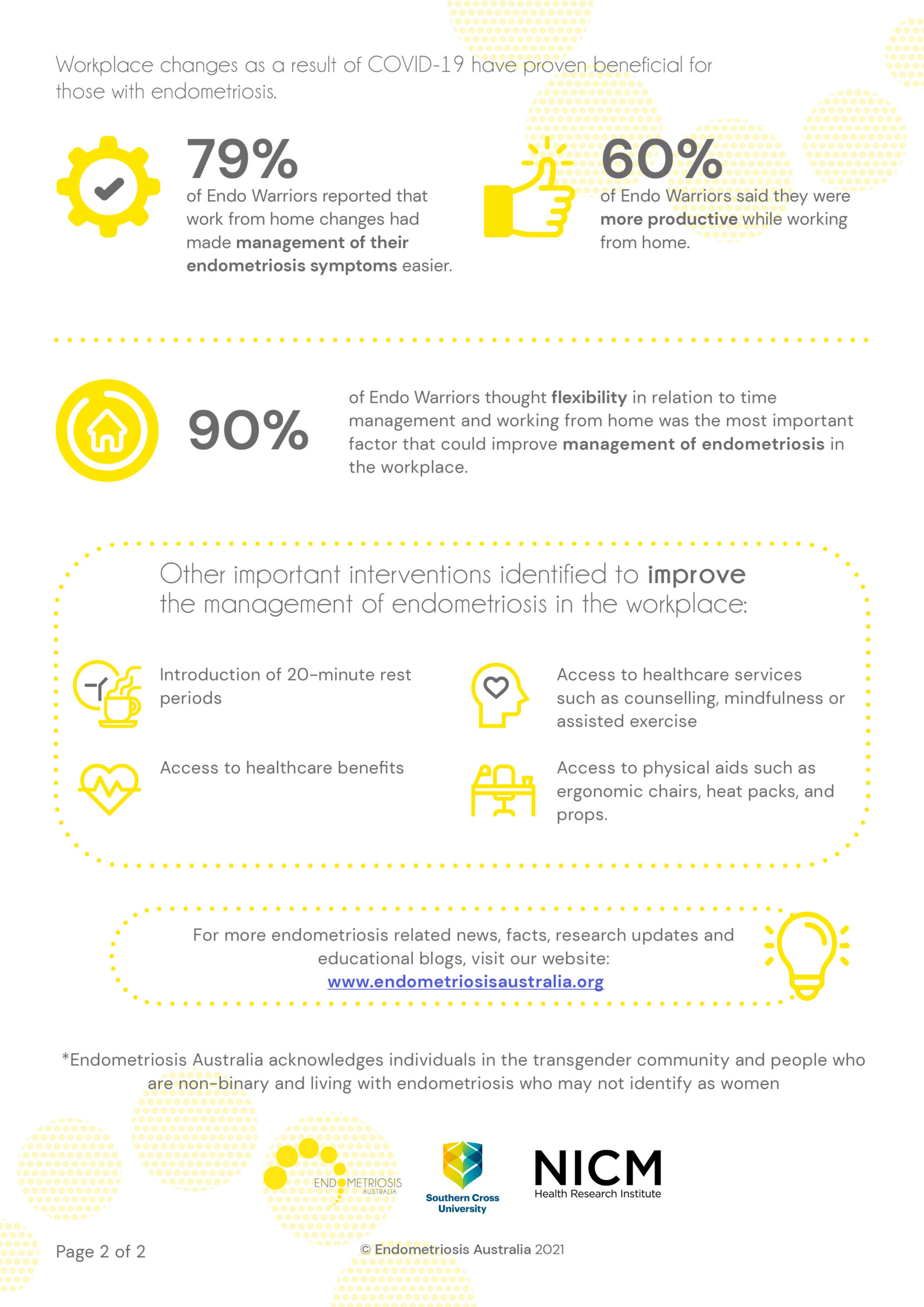Endometriosis is a common disease in which tissue similar to the lining of the womb grows in other parts of the body. Endometriosis has wide-ranging effects on patients, including physically debilitating symptoms, such as severe pain, fatigue, bloating and heavy or irregular bleeding.
In Australia over 830,000 women, girls, and those that identify as gender diverse are affected by endometriosis. A 2019 Australian study identified before the COVID-19 pandemic that many people reported having to take regular time off work (absenteeism) due to their endometriosis symptoms, often having to use unpaid leave to cover the 4 days per month they had off work on average. Even when they are at work, endometriosis patients often struggle due to pain and fatigue. Being at work but not able to work at your full potential is called presenteeism, and many people without endometriosis would be familiar with how difficult it is to work with a migraine or the flu. Presenteeism is the biggest contributor to the $9.7 billion dollars that endometriosis costs the Australian economy every year.
The pandemic forced many workplaces to make significant changes, most commonly requiring people to work from home. Given the impact endometriosis has on work, this was a unique opportunity to investigate the effect of these changes on those living with endometriosis. Simple solutions implemented during Covid-19 such as work-from-home may hold the key to helping endometriosis patients thrive in the workplace whilst still achieving a high level of productivity for their employers.
Impacts of endometriosis in the workplace
A collaborative survey published in the Australian New Zealand journal of Gynaecology (ANZJOG) by Southern Cross University, NICM Health Research Institute and Endometriosis Australia recruited three hundred and eighty-nine people with a self-reported diagnosis of endometriosis. Our research discovered that most people with endometriosis said the management of their endometriosis had a significant impact on their work-life pre COVID and showed that nearly two-thirds of those surveyed needed to take unpaid leave from work to manage their endometriosis symptoms.
Those with endometriosis often suffer for many years in silence. They feel isolated and are excluded from many work and life events due to the unpredictability of their symptoms. We found that nearly 50% of the patients surveyed said they had feelings of being judged and the associated stigma of this chronic illness when managing their symptoms in the workplace. Unfortunately, this judgement had some very tangible impacts with nearly one-third reported missing out on a promotion during their career as a consequence of their endometriosis symptoms. A very concerning one-in-seven respondents even reported being fired as a result of managing their endometriosis.
Thankfully most participants reported when they spoke to their employer about their endometriosis the response was positive, with only one in eight feeling the response was negative. However, nearly one-in-ten did not disclose their endometriosis at work because they did not feel comfortable to do so.
How ‘Work from Home’ impacts living with a chronic disease like endometriosis
During COVID-19, more than two-thirds of those in our study indicated that their workplace or employment arrangements had changed, most commonly working from home for at least some of their normal work hours. Our study found that 80% of respondents felt that working from home made managing their endo symptoms easier. Two-thirds of participants felt they were more productive when they could better manage their symptoms working from home. It appears that these enforced changes benefitted the majority of those with endometriosis and are relatively simple to continue in the post-pandemic Australian marketplace to make the workplace more endometriosis friendly. By creating a more flexible and agile endometriosis-friendly workplace, the result is win-win – it is easier for women to manage their endometriosis while also making them more productive employees. These changes may not only improve quality of life but start to reduce the $30,000 per year cost burden each woman with endometriosis in Australia currently experiences.
What workplace change during Covid-19 has taught us
Our research allowed us to look at endometriosis patients’ lives through the Covid-19 ‘work-from-home’ lens, and we discovered the opportunities this flexibility can offer to everyone with endometriosis. Workplace changes were reported for nearly 70% of patients surveyed, with key areas to help manage endometriosis symptoms identified to be workplace flexibility concerning time management and the capacity to work from home. Other suggested improvements included introducing 20-minute rest periods, better access to healthcare benefits, access to health services such as counselling, mindfulness or assisted exercise, better access to physical aids such as ergonomic chairs and the endometriosis patients ever-faithful heat packs.
Our work allowed us to confirm what we had suspected for some time – but it took a global pandemic to get the data to support these theories. Now we must advocate for ongoing workplace flexibility post pandemic. When that happens (and we must ensure it does!), this will enable patients living with endometriosis to achieve their career ambitions and contribute the $30,000 per patient back into the Australian economy.

Page 1 of 2

Page 2 of 2
Click here to view the research article
Written by,
Dr Mike Armour and Donna Ciccia

